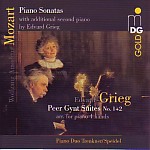Have you ever wondered how the finale of Mozart’s K. 545 C major sonata would sound with a second piano filling out textures, updating the harmonies circa 1877, and sneaking in elements from Grieg’s Piano Concerto? Would you like to hear the K. 283 G major sonata’s first-movement themes relentlessly harmonized in thirds, or the bass lines doubled in octaves? Or suppose that the K. 494 F major Rondo’s ethereal simplicity is not enough and requires a second pianist to supply decorative frou-frou? Perhaps the C minor Fantasy K. 475’s silences and stark unison lines prove insufficiently dramatic. No problem; simply extend that opening C-natural into a rumbling tremolo and add chromatic counter-lines all over the place. Really, who needs Mozartean expressive economy when you’re a 19th-century composer who knows better?
Seriously, however, there’s no need to get worked up over Grieg’s freely composed second piano parts to four Mozart sonatas. First of all, Mozart’s originals still survive intact, and always will (we hope). Secondly, Grieg’s additions wear their cleverness lightly and are never bombastic, overwritten, or pretentious. In fact, they’re actually quite pretty, if you accept them for what they are. For example, think of today’s DJs who remix classic jazz, or even contemporary classical composers like Steve Reich and Philip Glass; you might consider Grieg’s sonata arrangements (or “de-rangements”, if you will) the 19th-century equivalent. Perhaps Grieg might have had better luck pitching the works to his Leipzig publisher had he titled them “Mozart: the Grieg Remixes”.
Speaking of mixes, MDG’s ample, spacious surround-sound well suits the Trenkner/Speidel Duo’s genial, leisurely, lyrically oriented interpretations. The pianists generally favor slower tempos than the Prague Piano Duo on Praga, and they observe all the repeats. As a result, the music spills over onto a second CD, whereas the Prague Duo manages to squeeze all the works onto a single 79-minute disc. I personally find the Prague Duo performances more fluid, forward moving, imaginatively textured, and slightly more precise in regard to exposed unison attacks (the C minor sonata’s first movement, for instance). For some reason, the sonics acquire an unappealing metallic hue in the two Peer Gynt Suites (the piano’s “primo” register is particularly ugly) making me less inclined to endorse the Trenkner/Speidel duo’s heavy-handed pianism.
































